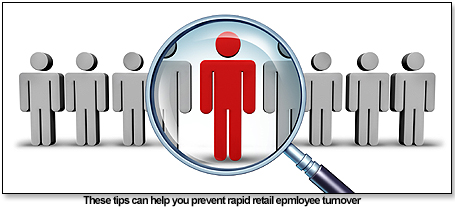
April 26, 2024

March 2014 | Vol. XIII - No. 3
8 Reasons Why Your Retail Employee Turnover Is So High
When employees leave – either because you fired them or they quit by choice – their absence leaves a hole.
Retailers hate holes… in merchandise, in displays and in schedules.
The more employee turnovers you have, the more holes you have to deal with, and the more costly it becomes. A CAP study found it costs, on average, $3,328 to find, hire and train a replacement for a $10/hour retail employee.
Hay Group reported a median turnover rate of 67% for part-time retail employees.
And while many businesses are adopting impersonal online application processes and pre-employment skill tests, they seem to do nothing to work on why their turnover is still so high.
Here are 8 reasons why your retail employee turnover is so high.
8. There are no incentives, except at the manager level. No one wants to work harder so someone else gets a reward. Find a way to include everyone somehow – not just on a sales goal but in keeping the “attaboy” attitude, so everyone feels good about the job they do for you.
7. Your policies or procedures are antiquated. No refunds, no exchanges, everyone works every weekend – all these stupid policies cause friction for good employees – and your customers. Examine your employee manuals and policies, and throw out those that are still rooted in the 50’s.
6. Your training is minimal. Just because an employee has previous experience does not mean they will understand what makes your store different. You have to tell them explicitly what you are trying to do with your customers and how it is different from every other retailer on your block.
5. Your employees are thrown into the job and not even introduced to the crew. Millennial employees don’t have the skill set to pro-actively meet other employees. You have to make an ongoing effort to bring people together, not keep them apart.
4. You don’t encourage employees to think, only to do. The younger workforce has an innately negative outlook. When they are forced to stock those shelves, price that merchandise, etc., it gives them plenty of time to say how much their job sucks.
3. You make every day the same. When every day is the same, employees get bored. Yes, customers can keep them interested, but we’re talking about the job itself. Many times we look at some employees as too valuable where they are. Mix it up for employees who have been with you for awhile; give them new duties, training, responsibilities, etc.
2. You hire the wrong people. Just because you’re tired of interviewing, you can’t just take anyone because they say what you want to believe. You need to see if they are able to talk to people, not just say they can.
1. You keep promoting employees who are good at tasks to supervisors. Employees quit managers, not brands. Promoting someone because they get things done isn’t the only criteria. Those managers with poor interpersonal skills will be tolerated by a certain type of employee, but the best employees will move on quickly. A manager’s main job is to develop a crew who feels it is their store, and not leave them feeling like they are a cog in a wheel.
In sum
When you have to fire someone – and you should on a regular basis if you are truly managing the business – see how their behavior might have been crippled by your training. And when someone quits, seek to discover what the interpersonal dynamics were of the people they usually worked with.
Only when you are willing to dig deeper into the soft belly of your organization will you be able to fortify yourself from the knife of high turnover rates.
Copyright © 2024 TDmonthly®, a division of TOYDIRECTORY.com®,
Inc.



